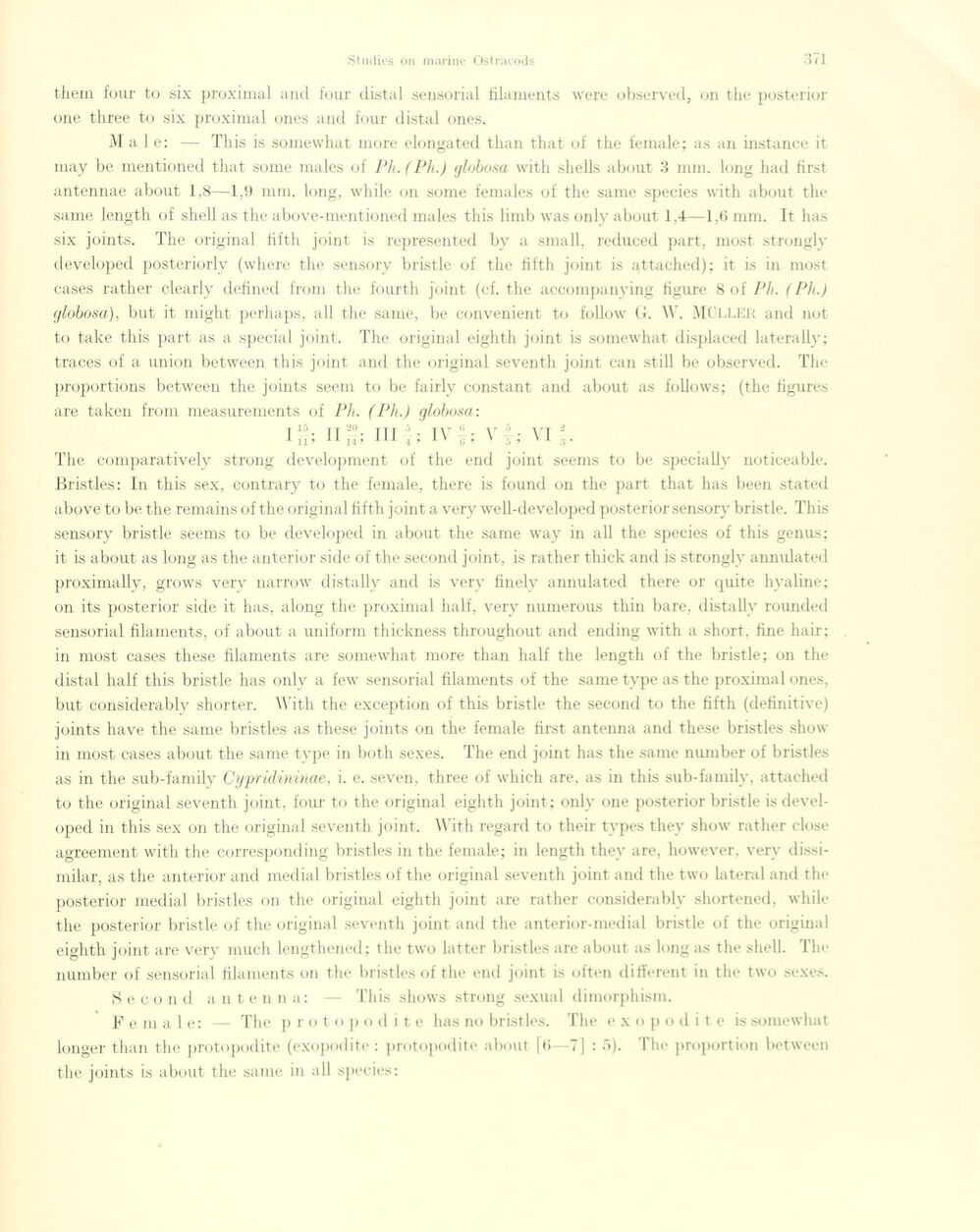
Full resolution (JPEG) - On this page / på denna sida - Sidor ...

<< prev. page << föreg. sida << >> nästa sida >> next page >>
Below is the raw OCR text
from the above scanned image.
Do you see an error? Proofread the page now!
Här nedan syns maskintolkade texten från faksimilbilden ovan.
Ser du något fel? Korrekturläs sidan nu!
This page has never been proofread. / Denna sida har aldrig korrekturlästs.
thern four to six proximal and four distal sensorial filaments were observed, on the posterior
one three to six proximal ones and four distal ones.
M ale: — This is somewhat more elongated than that of the female; as an instance it
may be mentioned that some males of Pli. ( Pli.) globosa with shells about 3 mm. long had first
antennae about 1,8—1,9 mm. long, while on some females of the same species with about the
same length of shell as the above-mentioned males this limb was onlv about 1,4—1,6 mm. It lias
six joints. The original fifth joint is represented bv a small, reduced part, most strongly
developed posteriorly (where the sensory bristle of the fifth joint is attaehed); it is in most
cases rather clearly defined from the fourth joint (cf. the accompanying figure 8 of Pli. (Ph.)
globosa), but it might perhaps, all the same, be convenient to follow G. W. Müller and not
to take this part as a special joint. The original eighth joint is somewhat displaced laterally;
traces of a union between this joint and the original seventh joint can still be observed. The
proportions between the joints seem to be fairly constant and about as follows; (the figures
are taken from measurements of Ph. (Ph.) globosa:
In; Un; m IVr, V U VI
The comparatively strong development of the end joint seems to be specially noticeable.
15 ristlr>: In this sex. eontrary to the female, there is found on the part that has been stated
above to be the remains of the original fifth joint a very well-developed posterior sensory bristle. This
sensory bristle seems to be developed in about the same way in all the species of this genus;
it is about as long as the anterior side of the second joint, is rather thick and is strongly annulated
proximally, grows very narrow distally and is very finely annulated there or quite hyaline;
on its posterior side it has, along the proximal half, very numerous thin bare, distally rounded
sensorial filaments, of about a uniform thickness throughout and ending with a short, fine hair;
in most cases these filaments are somewhat more than half the length of the bristle; on the
distal half this bristle has only a few sensorial filaments of the same type as the proximal ones,
but considerably shorter. With the exception of this bristle the second to the fifth (definitive)
joints have the same bristles as these joints on the female first antenna and these bristles show
in most cases about the same type in botli sexes. The end joint has the same number of bristles
as in the sub-family Cypridininae, i. e. seven, three of which are, as in this sub-family, attached
to the original seventh joint, four to the original eighth joint; onlv one posterior bristle is
developed in this sex on the original seventh joint. With regard to their types they show rather close
agreement with the corresponding bristles in the female; in length they are, however, very
dissimilar, as the anterior and medial bristles of the original seventh joint and the two lateral and the
posterior medial bristles on the original eighth joint are rather considerably shortened, while
the posterior bristle of the original seventh joint and the anterior-medial bristle of the original
eighth joint are very much lengthened; the two latter bristles are about as long as the shell. The
number of sensorial filaments on the bristles of the end joint is often different in the two sexes.
Second antenna: — This shows strong sexual dimorphism.
Female: — The p rotop odite has no bristles. The e x o p o d i t e is somewhat
longer than the protopodite (exopodite : protopodite about |<> Tj : 5). The proportion between
the joints is about the same in all species:
<< prev. page << föreg. sida << >> nästa sida >> next page >>